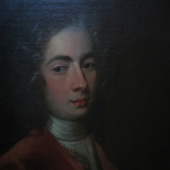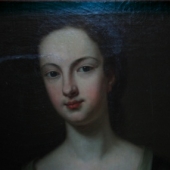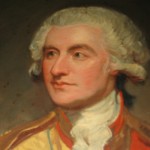The Jacobite Rising of 1745. George Mackenzie, 3rd Earl of Cromartie was initially reluctant to ‘come out’ for Prince Charles Edward Stuart but was persuaded by kinsmen including the ‘Old Fox’, Simon Fraser, who handed George, a young man, with his great-great-grandfather’s sword, the modestly entitled ‘The Triumphing Sword of the Clan Mackenzie’, telling him to support his Prince. This, plus a strong sense of being a Highlander in debt to the Hanoverian tax man, encouraged both him and his son John to join the Princes forces.


John was captured with his force of four to five hundred men after the Battle of Meikle Ferry on the southern shore of the Dornoch Firth whilst George, after nominally capturing Dunrobin castle and having a glass of wine with the Countess of Sutherland (who had Jacobite sympathies), was surprised when General Louden came to demand Cromartie’s surrender. He attempted to hide behind a curtain with the Countess standing in front. Unfortunately he left a foot sticking out and one of Loudens officers proclaimed ‘My Lady has three legs’, and George was taken prisoner with his son and the remainder of his troop.
Both were taken down by ship to the Tower of London, George in the Bloody Tower and John in the Wakefield Tower. Georges wife, Isabella Gordon, known as ‘Bonnie Belle’ who was six months pregnant, then rode in three days from Castle Leod to the Tower, an extraordinary feat of stamina and horsemanship considering the so-called ‘roads’ in those days.
Once there she ordered ’suits of mourning’, well aware that the sentence for High Treason was death. At the trial of the four Jacobite peers of Lovat, Balmarino, Kilmarnock and Cromartie, sentence was a forgone conclusion. Cromartie, like the others had their titles ‘attainted’ and their estates confiscated. Contemporary prints show the scene of Lord Lovat’s beheading on Tower Hill, with the scaffold surrounded by thousands of spectators. Bonnie Belle however was made of stern stuff; she managed to get a Petition together and succeeded in presenting this to the King, George the Second outside Kensington Palace chapel. She, surrounded by ‘wailing children’, fainted at the Kings feet, whereupon he lifted her up. She was aided by the Kings eldest son, Frederick Prince of Wales and his wife, who not only took pity on poor Bonnie Belle but actively worked against the King. Public reaction to the aftermath of Culloden and the rather loathsome ‘Butcher Cumberland’s’ slaughter of innocents and wounded had worked in Cromartie’s favour and his death sentence was commuted to life in exile in Devonshire. He lived mainly in Honiton where there is still a Cromartie Drive but died, in poverty, in Walpole Street in London. Until his death his wife and family received no estate money save what was smuggled out of the by now Hanoverian run Cromartie Estate, by their loyal factor.
Having seemingly lost all, it was then spectacularly regained by John. He spent many years as a soldier in Sweden, attaining a high rank and becoming an Earl Marichal as well as being created ‘Count Cromartie of Sweden’.
His return to Scotland was welcomed by the Government who recognised his military brilliance and together with his brother George, they raised what was then known as ‘Lord Macleod’s Regiment of Foot’(later to become the Highland Light Infantry). The MacLeod title, a courtesy one, is held by the Chief of the Mackenzies’, contrary to what might be expected. It featured in the TV show ‘Mastermind’ and none of the contestants got the correct answer!
John and George then were sent off to fight in India against the able Hyder Ali where they had numerous battles and near escapes. John managed to persuade the British Government that Highland troops were better fighting machines if dressed in lighter uniforms suitable to the tropics and not to damp and cold Scotland!
Unfortunately George his brother was killed and is buried in Madras and John eventually returned home as a Major General and in 1784 managed to buy back Cromartie Estate for the huge sum in those days, of £19,000, the amount of back taxes owing to the Hanoverian Government. He made Castle Leod his home as well as that of the more comfortable and modern Tarbat House and on his death the estates passed to his eldest sister, Isabella. Several generations of daughters owned the estates and on marriage the husband took on the name Mackenzie giving precedence to their wives’ name .
It was not until Queen Victoria made Anne Hay Mackenzie, The Countess of Cromartie in her own right, that the titles were restored. A marriage to the Duke of Sutherland brought much needed cash to the impoverished estates and further building work extended Castle Leod northwards behind the Tower.

